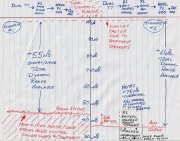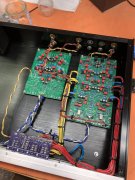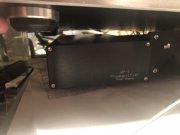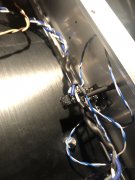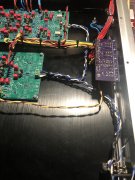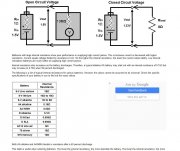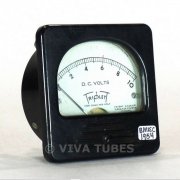2) How to mod these phono preamps -- which parts in which order, & why
OK, here's a bird's eye view of the component side of the module. Bonus points if you print out an 8 1/2" x 11" copy (~3x magnification) so that you can easily follow along:
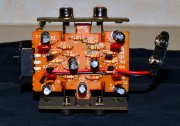
Also, here's a marked up copy of the schematic so that you can see the signal paths through the preamp:
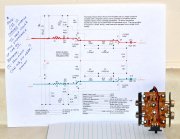
In order to take an 25+ year-old module and bring it back to new/better than new performance, the basic concept is to remove obsolete/end-of-life (dried out) components and repopulate the module with newer/better parts. (ie: A basic renewal instead of a redesign.)
Here's something I drew up to break this module upgrade into 3 steps:
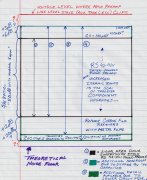
Arrow (1) shows what the claimed 50 dB signal/noise ratio of a new board with the stock components to give you a visual perspective.
Arrow (2) is showing the theoretical
dynamic range improvement available if a perfectly stable 9V power is fed to our (4) transistors on the board. Of course the way I drew it could make one think that I'm saying that there would be more gain from the circuit at all times, even with a steady-state test tone. I am not saying that. Instead, I am trying to fix the 9v power 'bouncing' underneath our active devices during transient demands.
Instead, to help illustrate this point, let's on purpose temporarily
worsen the design & see what happens. Let's remove the original 100uf
C11 (upper lefthand corner of schematic, physically located right between the L & R output jacks on the board) ...and install a *
1* ufd cap in it's place.
You see, the battery isn't plugged
directly into the module; instead, the obvious need for battery servicing by the human & product packaging reasons the battery is electrically connected to the board by a ~4" pair of red/black wires. So, when a Bonham crescendo comes along, the transistors draw current simultaneously, the replacement current can't be sourced from the battery fast enough, so C11, acting like the on-board 9V 'water tower', keeps the pressure (voltage) steady in our power circuit. (this function is referred to as
"Transient Load Decoupling", section 4 of this wiki entry.)
But remember, at the C11 position we took out the original 100 ufd cap & replaced it with a 1 ufd cap. So now, instead of our 4 active components having a (relatively) unwavering power source to draw from, the instantaneous voltage is dependent upon the relationship between the battery & wiring vs. the rate of instantaneous current draw by the 4 transistors.
With a 1 ufd cap in place, now our listening experience to complex, dynamic music will *vary* depending upon the internal design of different vendor's batteries - the more expensive ones that can deliver the current more rapidly will 'sound better' (soundstage won't collapse during transients, impact/slam won't disappear, etc) ...as opposed to the cheaper batteries where the internal design is 'good enough/cheap enough' to work in non-critical (normal) usage. I would posit that with the worst-case battery setup, that during a Bonzo bass drum triplet that the 1st kick would sound different than the 3rd kick. (Approx.
1:20 into this very interesting video.)
Given the above, when some of the more critical listeners would say a) this battery powered phono preamp sounds better with brand X battery vs. brand Y, I believe that they were on to something. (But they were derided in public by some for saying this.) Furthermore, the ones that said that instead of using 1 preamp in stereo mode, that using 2 at a time, 1 for each channel, the sound was further improved...I also believe that.
(NOTE: At this instant in time I wish I had the lab put together, for I would put the 1 ufd C11-equipped phono preamp against the (stock) 100 ufd. And I would set it up so that the viewer could actually
hear the differences in the music while also watching the bouncing vs. nonbouncing 9v traces on the scopes. So now that they know what to look for, we would experiment with listening to the (stock) 100 ufd vs. a 470 ufd or even a 1000 ufd. Q: Where does the sonic benefit start to taper off? A: I don't know...yet. (!)
****
To put this into perspective, let's go back and revisit those 'cost no object' battery-powered phono preamps. For example, where the cost-conscious Korean bean-counters allowed our designer to use a
100 ufd capacitor at C11 -- meanwhile, the
ASR Basis Exclusive uses a whopping 400,000 ufd of local storage for this same exact 'Transient Load Decoupling" function. (!) There's a lot that I don't know, but I *do* know that if we were to put 400,000 ufd of local storage & connected it to the C11 position, we would no longer be able to hear the differences between battery brands, no matter how dynamic the music we are listening to. (Actually, once it was charged up, we could completely remove the 9v battery...and the music would simply play on! :0)
****
OK, so after reading all this, I haven't even given the reader an upgrade recommendation for this critical C11 position. But if you read through this post, here is something that you can do. Remember the eBay guy selling this same preamp that has been 'recapped for better performance' for $99? If you go back to
entry #46 & look at his photo, you will see that he did *not* upgrade C11 from the stock size?
Was he right, or was he wrong? At the moment, I had to admit that all of the above is pure conjecture...but once I put my audio test lab together & make some real-world measurements I will be able to come back to this discussion & tell you if 100ufd is really all you need...or that I found a 470 ufd from Panasonic that is thin enough to swap in + short enough to fit back into the stock box. (~75 cents apiece) ...but the real deal, sonically speaking is to mount this board
inside a cigar box , giving you plenty of room to fab up a Panasonic (10) x 1000 uf array =10,000 uf cap bank for a scant $6.75 to the door:

(And yes, I know that the caps with a good reputation are being counterfeited. And that you can probably improve on the price at a digikey or mouser -- but I just needed a quick screen grab showing how it would be possible to improve local storage a 100 times (100 ufd > 10,000 ufd) in this position for <10 bucks + cigar box + cap bank wiring.)
Just food for thought. No doubt 10K uf is overkill for this preamp, and of course 1uf is too little -- so in order to come up with an intelligent, defensible answer we need to instrument *and* listen at the same time in order to come up with some hard-won power subsystem knowledge...of course, the 'non-bean counter restricted answer' is somewhere between these extremes...
In the interest of science!

